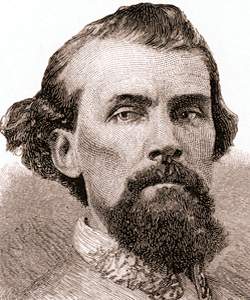Nathan Bedford Forrest, Fort Pillow (American National Biography)
Scholarship
The attack on Fort Pillow, 12 April 1864, was the battle that brought his name to the attention of the U.S. Congress and to the northern press.
The bare facts of that attack were that 221 defenders were killed, 130 were wounded, and the remainder were captured. An uncounted number of civilians who had taken refuge in the fort were also killed. The high military casualty rate stunned the North, and rumors spread that Forrest had ordered a "Black Flag" or "no quarter," which led to the massacre of many of the African-American defenders. His troops pursued men into the woods and continued to fire on the fleeing defenders, killing many as they sought to escape. Later, Forrest's supporters and friendly biographers collected evidence from both Confederate and Union veterans of the battle to offset the conviction that he was personally responsible….
The congressional committee investigating the battle concluded that Forrest had taken advantage of a truce to reposition his forces and that he had allowed his troops to commit the slaughter. The committee heard testimony that some wounded Union troops were intentionally burned in their barracks, while other wounded were buried alive. Since Forrest was a slave trader before the war, his battle tactics were unconventional, rapid, and ruthless, and he had a personal reputation for certainty of purpose and strict discipline against any of his men charged with cowardice or violation of orders, he became a convenient symbol of the violence and sometimes explicit racism of the rebellion.
The bare facts of that attack were that 221 defenders were killed, 130 were wounded, and the remainder were captured. An uncounted number of civilians who had taken refuge in the fort were also killed. The high military casualty rate stunned the North, and rumors spread that Forrest had ordered a "Black Flag" or "no quarter," which led to the massacre of many of the African-American defenders. His troops pursued men into the woods and continued to fire on the fleeing defenders, killing many as they sought to escape. Later, Forrest's supporters and friendly biographers collected evidence from both Confederate and Union veterans of the battle to offset the conviction that he was personally responsible….
The congressional committee investigating the battle concluded that Forrest had taken advantage of a truce to reposition his forces and that he had allowed his troops to commit the slaughter. The committee heard testimony that some wounded Union troops were intentionally burned in their barracks, while other wounded were buried alive. Since Forrest was a slave trader before the war, his battle tactics were unconventional, rapid, and ruthless, and he had a personal reputation for certainty of purpose and strict discipline against any of his men charged with cowardice or violation of orders, he became a convenient symbol of the violence and sometimes explicit racism of the rebellion.
Rodney P. Carlisle, "Forrest, Nathan Bedford," American National Biography Online, February 2000, http://www.anb.org/articles/04/04-00389.html.
Nathan Bedford Forrest, Military Career (American National Biography)
Scholarship
Forrest's military victories were remarkable for several reasons. First of all, he was not a literate man, and his writing reflected the fact that he never mastered spelling or standard grammar. As a consequence, some of his reports and communiqués that survive have a distinctly illiterate flavor when published without editing or correction. However, he was reputed to be excellent in mathematics, and his personal business ventures demonstrated the truth of that observation. Furthermore, he had no military training whatsoever. Thus, his tactics were entirely based on his own thoughts about his own forces and the disposition of the enemy. He moved rapidly, perfecting the techniques of the surprise raid, the flanking and rear attack, and escape through unexpected routes. Military observers at the time and later concluded that Forrest was a natural military genius. He had few precepts but was quoted as saying that his rule of war was to "get there first with the most men," a motto that was often attached to his name. A tall and commanding figure, usually astride a horse, he was revered by his men. Forrest was wounded several times. By the careful count of one admiring biographer, he had twenty-nine horses shot while he was riding them and was personally responsible in hand to hand combat for the death or serious injury of thirty Union officers and men.
Rodney P. Carlisle, "Forrest, Nathan Bedford," American National Biography Online, February 2000, http://www.anb.org/articles/04/04-00389.html.



